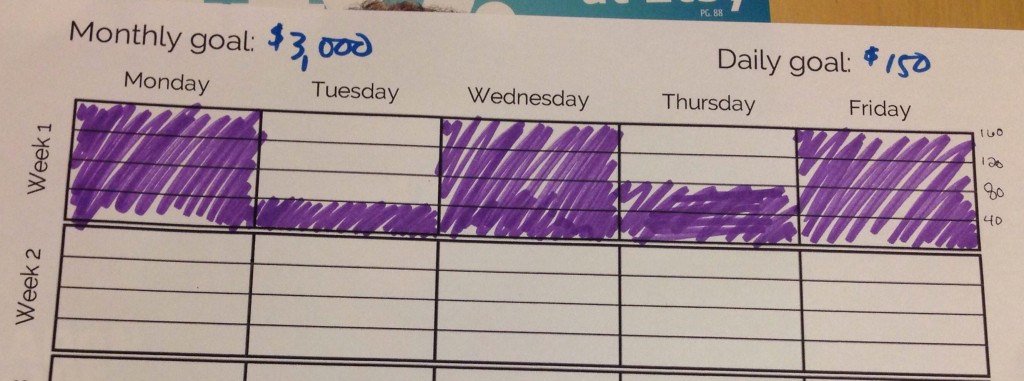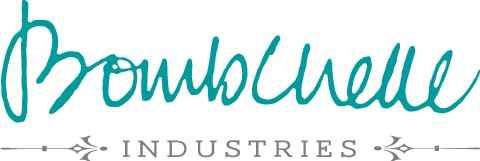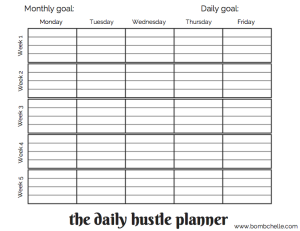
Going back to full time freelancing, my goal has been to do things differently (i.e., better!) this time around. One of the things that was a personal shortfall last time is that I was definitely not great at breaking my income goals down into smaller chunks and actually keeping track of money coming into my business. I had weekly goals, but I didn’t really keep track in any easy to use visual manner.
I needed a way to see at a glance how I was doing on my income goals, and gauge the effectiveness of my pricing. And – you know me – I couldn’t find one (…that didn’t involve spreadsheets, gag me), so I made it.
Click on the image to download your printable:
How to use it:
It’s a pretty simple idea:
- Take your monthly income goal (I used $3,000 for this example, since…that’s what I’m using right now as a realistic guess for my first full month back at freelancing)
- Divide that by 22 (which is the average number of work days in a month, though if you wanted to get super anal-retentive you could count the actual work days in any given month)
- Ta da! That’s your daily goal.
The planner functions as a bar graph, and each day is divided up into four sections for 25, 50, 75, and 100%. In my example, 150 doesn’t divide evenly by four (37.5 is not a very bar-graph-friendly number), so I just rounded up and have it go by increments of 40 instead.
Here’s what mine looks like right now:

(I went ahead and filled in guaranteed income for Wednesday, Thursday, and Friday, just to help illustrate the usage – normally I wouldn’t color that in until it had been worked and/or paid)
The specifics of how I’m using it:
- I’m tracking the work I do, as long as I know I’ll get paid for it. For example, if I write a 1,500 word post for a client, that’s my goal met for the day and I mark the day as complete – I don’t count the income on the day the invoice gets paid. (This could potentially bite you in the ass with a non-paying client, but again, the idea here is not detailed financial tracking; this is meant to be an at-a-glance planner that keeps your nose to the grindstone.)*
- The exception to this is if someone buys a product on a particular day – that income goes on that day or the next blank day.
- For money that comes in during the weekend (by which I mean, a product sold or a class enrollment, etc.), you can either not mark it on the hustle planner, and it’ll be some extra padding, or you can roll it over to the next Monday.
- If you really wanted to, you could color code by products vs. services vs. classes, but I’m not.
*Part of the reason I’m doing it this way is that one of the recurring issues I had before was that people would pay a retainer, then I’d count the retainer income as being a full week’s (or two weeks, etc.) income goal, without actually having worked off the retainer yet. As you know if you’ve done this, this catches up and you wind up incredibly overworked at some point in the future. This is part of my way of fixing that problem.
This is useful because:
It keeps the focus on arguably the most useful metric: money. It’s too easy to get swept up in “OMG! I got 10 new email signups today!” and think that that means you can take an afternoon off, or work on things that won’t necessarily generate ROI. Looking at your guaranteed income keeps you realistic as far as what you need to plan for pitching, marketing, and sales each day and week. It keeps you hustling. (Hence the name.)
It also makes my work-day really simple: I outline my work for the day, I work until the day is full and I’ve met my income goal, and only then do I work on email, social media, marketing, writing blog posts, and so on.
Using this planner is super helpful in setting priorities – if you’re nearing the end of the first week of the month, and see you’re “blocked up” through the end of the third week in the month, you don’t have to spend as much time or energy on sales/pitching in your after-goal time – instead, you can work on something that might have a longer-term return on investment (like writing a blog post or pitching guest posts).
It’s also a handy metric for knowing if your pricing is way off. If you regularly find yourself finishing a 6-8 hour work-day without having made that goal amount yet, or you do make the goal amount but you’re so freakin’ exhausted you don’t have any time left for admin and marketing, then you need to raise your prices. Administrative details and marketing is a huge part of what goes in to freelancing and/or running a business, and if there’s not enough time for that, then something’s broken somewhere along the line.
It can be really easy to spend far too much time researching the latest social media trends or reading the newest post from your favorite marketing blogger or dicking around on Facebook “networking.” This planner helps keep your attention on the hustle – hope you enjoy it!
PS: I’ve got some awesome news coming up on Friday, and some of that awesome news will only be available for subscribers – make sure to sign up for the newsletter below or here to make sure that you don’t miss it!

